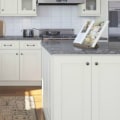Wall cabinets are mounted on the wall and typically store kitchen items such as cups and plates. The height of these cabinets varies depending on the height of the ceiling and the free space of the countertop. This free space is usually 15 to 18 inches long to accommodate traditional kitchen appliances. Wall cabinets depend on the ceiling height you have in your kitchen. Yes, cabinet depths can be reduced to fit narrow aisles or specific dimensions.
The bottom, sides, top and even the shelf can be cut to size. Here's a simple and comprehensive guide to the basic dimensions of your kitchen cabinet so you can find out which size is best for you. Standard wall cabinets are typically 12 inches deep, providing enough space for a countertop workspace underneath the cabinets. The standard depth of the wall cabinet is 12 inches and 24 inches deep above the refrigerator for easy access. When designing a kitchen with a staggered height cabinet look, it's important that you make taller cabinets 3 to 15 inches deeper.
This leaves room for the crown moldings of lower height cabinets to end well on the sides of the cabinet and not block the door opening of the higher cabinet. Height = 720 mm, Depth = 560-600 mm, Widths = 150, 300, 350, 400, 450, 500, 600, 800, 900, 1000, 1200 mm, Pedestal = 150 mm, Thickness of the countertop = 600-650 mm (cabinet depth + cantilever on the front), total height = 890-910 mm height = 1825, 1950, 2150 mm (cabinet only)), Depth = 560-600 mm Width = 300, 400, 450, 500 mm, Plinth = 150 mm. We offer a free design service with a guide on how to measure your kitchen and a detailed list of your kitchen items. The most important factor is the location of key work centers in the kitchen as well as the relationship between kitchen characteristics. Wall cabinets can be used for additional storage and to introduce a little more style into your kitchen design. The approximate numbers of the kitchen measurements can help start the design of the kitchen but it is advisable to have the help of a professional to verify these numbers. These cabinets can make all the difference for general storage and ease of access throughout the kitchen.
For example, two tall cabinets in a spacious kitchen - one with many removable modules and shelves and another with almost none - could eliminate the need for a separate pantry and at the same time allow you to store (and easily access) mops, brooms, buckets, steamers, vacuums and floor polishers. Take note of any ceiling moldings above the kitchen cabinets as well as the height of other wall cabinets. Base cabinets hold larger kitchen items such as a KitchenAid mixer, large pots and other items that you're less likely to move. Determine the right cabinet design, relocate appliances to new locations, add cabinets to increase storage, create a kitchen island for a beautiful open concept and much more. Oven cabinets start from 30 wide to 33 inches (33 is the most common oven cabinet that can accommodate 90% of ovens on the market). Average wall-mounted or overhead kitchen cabinets are 30 to 42 inches high, 12 to 24 inches deep and 9 to 36 inches wide.
These are just a few examples of easy and relatively inexpensive ways to increase standard functionality of kitchen cabinets. These are often the most fun cabinets as you can add lighting, glass and other features to add more personality to your kitchen. A kitchen wall cabinet 15 to 18 inches deep is standard over a microwave oven while deeper cabinets with a depth of 24 inches are commonly used above refrigerators. Otherwise you're likely to find enough standard and semi-custom kitchen cabinet configurations for your needs.


